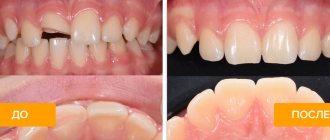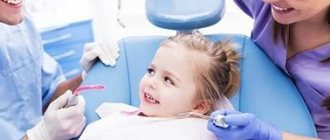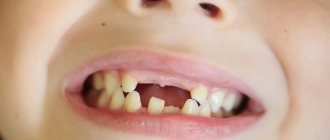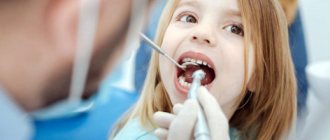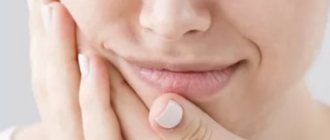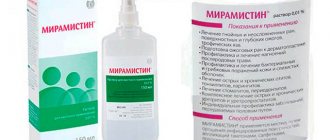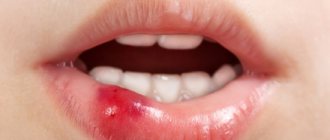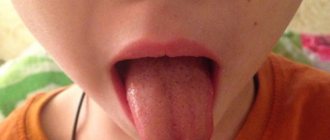A tooth injury is a bruise, dislocation or fracture as a result of a blow, fall or other mechanical impact. Most typical:
- Injury to the front milk teeth in children aged 1-2 years, when children are just starting to walk, but still have poor coordination of movements, often fall and hurt themselves, and run into hard objects.
- Dental trauma at the age of 7-10 years, when children learn to rollerblade and skateboard, play ball, climb, and sometimes fight.
Chronic injury is also possible when a child constantly chews hard objects, and chips of enamel and microcracks appear on the teeth.
IMPORTANT! Information from the article cannot be used for self-diagnosis and self-medication! Only a doctor can prescribe the necessary examinations, establish a diagnosis and draw up a treatment plan during a consultation!
Bruised baby tooth in a child
Most often, bruises occur in preschool children with baby teeth. In appearance, the bruised tooth may not be in an arch with the rest of the teeth, it may look slightly raised above the other teeth due to swelling of the gums. The tooth hurts when chewing and pressing. If a child’s tooth is bruised, what should parents do? The best thing to do in this case is to apply cold to the area of swelling on the face and take the child to the dentist, and if he has determined for sure that this is indeed a bruise, treatment will most likely not be required. It is enough to avoid hard foods for a month to give the tooth the opportunity to “grow” back. In some cases, an incomplete dislocation of the tooth is added to the bruise, and the dentist, under local anesthesia, will set the tooth in place and fix it with a splint.
Children learn about the world around them through various sensations: visual, auditory, gustatory, tactile. However, the instinct of self-preservation is not yet sufficiently developed in little fidgets, so they often commit actions, the consequence of which, for example, can be injury to baby and permanent teeth in children, i.e. deformation, violation of the anatomical integrity of the tooth and adjacent tissues.
What are the types of injuries and their characteristic symptoms?
Injury
A bruise is understood as the impact of brute force from the outside on a tooth, in which its integrity is not broken. Immediately after such damage and some time later, the baby may complain of pain when eating or during hygiene procedures. In some situations, the damaged unit may become mobile.
Dislocation
A dislocation is an injury to the ligamentous apparatus, connective (periodontal) tissue, as a result of which the coronal part or root changes its location or is displaced. There are several options for the development of events:
- when the dislocation is incomplete: the tooth is in the socket, but its crown part deviates, its position relative to other teeth changes. In this situation, the periodontal connective tissues suffer little or not at all. The baby experiences pain while eating and complains that an incorrectly positioned tooth is bothering him. Also, sometimes the lip and gums swell, and there is slight bleeding from the area of injury,
- when the dislocation is complete: the contact of the tooth with the socket is broken, i.e. connective tissue is torn. The damaged unit can either fall out completely or be held in the socket only by the gums. In the first case, a blood clot may appear in the hole; in the second, the tooth becomes extremely mobile. The damaged area hurts, sometimes it may bleed, there is swelling of the soft tissues,
- when the dislocation is impacted: this situation is considered one of the most common in primary occlusion. When damaged, the tooth is deeply immersed (hammered) into the socket (for example, due to a powerful blow) with penetration into the jaw tissue. As for the tooth itself, it is firmly held in the oral cavity, remaining immobile. However, relative to its “neighbors,” it changes its position and is positioned incorrectly (it tilts or rotates along its axis). Upon examination, it may seem that it has become shorter than other units of the dentition, and it may also completely “hide” in the gum. This option is very dangerous, because with such an injury all tissues are deeply damaged, and when the upper incisors and canines are injured, sometimes there is a risk of damaging even the nasal and maxillary sinuses. The damaged area hurts, the lip and gums in the damaged area are swollen, and the mucous membrane may bleed.
If the injury is severe, tooth dislocation may occur.
Fracture of a tooth crown or root
Dislocations occur most often in temporary and permanent dentition. Less common are root fractures. Injuries can complement each other, for example, a root fracture can be combined with a crown fracture.
Even if the damage does not seem serious, and the child does not express complaints, you need to contact the dentist as soon as possible. Only a specialist can objectively assess the overall picture and decide what to do next. Timely consultation with a doctor will help avoid unnecessary complications.
A tooth fracture implies serious injury to it due to brute force, leading to disruption of the natural structure of the crown or root. The crown can break (chip off) at the enamel level, in the dentin area, or entirely. A minor chip in the enamel does not always bother young patients and their parents, while a chip in the dentin area or a completely chipped, destroyed crown is a serious visual defect. In addition, this situation can also threaten the pulp; traumatic pulpitis often occurs against this background. Also, the sharp edges of the injured unit scratch the tongue, lip, cheek, and interfere with the complete chewing of food. Naturally, in this case, the baby may experience a painful reaction to temperature stimuli and mechanical influences.
Root fracture in childhood is not a common occurrence. The roots of the incisors in the permanent dentition are most vulnerable. A fracture of the root of a baby tooth in a child is observed in exceptional cases. This is explained by the anatomical features of the temporary units and their alveolar process. There are oblique, longitudinal, fragmentation, and combined root fractures. The child experiences pain when biting and chewing food and complains of a loose tooth.
How to solve a problem
Different types of injuries require different approaches to treatment. In all situations, the first stage remains unchanged - visiting the dentist. The doctor will ask about the cause of the injury, complaints, conduct the necessary diagnostics and, depending on the nature of the injury, prescribe treatment:
- in case of bruise: the most important thing is to provide the injured unit with rest, excluding it from the process of chewing food. The nature of the diet will need to be changed by temporarily removing solid foods rich in hard fibers from the diet. Additionally, medications with anti-inflammatory effects may be prescribed. If injury or inflammation of the pulp occurs as a result of the bruise, it will be removed and the canal will be carefully sealed,
- in case of incomplete dislocation with displacement: first of all, the tooth is returned to its correct position. Then it will be fixed with the help of special dental splints, which will not allow it to move again. During the rehabilitation period, it will also be important to follow a gentle diet,
- in case of complete dislocation: the tooth can be removed from the socket, the necessary preparatory procedures can be carried out, and then replanted again (replantation), fixed for a while with splints. In such a situation, it is important to consult a doctor as early as possible, otherwise the chance of successful replantation decreases in proportion to the increase in the time during which you ignore the problem,
- for impacted dislocation: in a child under 2 years of age, the doctor chooses a waiting tactic, because the damaged tooth can recover and continue to grow normally. If this does not happen, most often it is necessary to remove it and think about subsequent prosthetics,
- in case of a crown fracture: if we are talking about a minor chip, then the problem can be solved with the help of restoration - applying a composite material or filling. In case of significant damage, it is more advisable to install a stump inlay or crown, build up a tooth on a pin,
- when the roots of the mammary unit are fractured: it is often simply removed. The same will be done for vertical and comminuted fractures in any bite. If the roots of permanent teeth are fractured, further treatment will depend on the condition of the pulp. Further, restoration will take place through prosthetics.
It should also be remembered that if, as a result of the removal of even the very first, baby tooth, it is very important to promptly take care of the issues of its prosthetics. There are special soft children's dentures that will allow you to preserve the aesthetics and functionality of the dentition for some time - until the primary bite is changed to a permanent one or until the jaw systems are fully formed, when it will be possible to consider the option of higher-quality prosthetics, for example, using dental implantation.
Tooth dislocation in a child
A tooth is said to be dislocated if the tooth falls out completely as a result of an impact or is turned out of its socket and is supported only by soft tissues. A dislocated baby tooth in a child is usually not treated; the dentist simply removes it permanently. A permanent tooth can be saved if it is dislocated, but only if the roots of the tooth are not broken, and if it is possible to deliver the tooth to a dental clinic within two hours after the injury, and until that moment keep it in water (it is best in mineral water or in milk) so that the pulp does not have time to die. The dentist carefully sets the tooth into place and applies a splint.
Impacted dislocation of a baby tooth also occurs in children. With this injury, the tooth seems to go inside the gum. In this case, the dentist may recommend not to intervene and simply wait until the injured tooth begins to “erupt” again. Do not try to remove it from the socket yourself; this may damage the buds of the permanent tooth under the injured milk tooth.
Causes of dental damage in children
The increase in injury cases is primarily due to the growing popularity of team, contact and other sports. For example, hockey, wrestling, boxing, football and others. Also, the cause of dental damage in children of different ages can be accidental falls during active games on the street or school. No less common are injuries sustained in everyday life, fights, road accidents and other cases where there is a high probability of being hit by a hard object.
The risk of tooth damage increases if a child has orthodontic pathologies. For example, in patients with a distal bite (with protrusion of the upper jaw), injuries occur 5 times more often than in those with an orthognathic (normal) bite.
Also, dental damage often occurs in children with visual impairments, problems with the musculoskeletal system and various neuropsychiatric diseases.
What to do if a child has a dental injury
- If the injury is combined with a fall or a strong blow, you should immediately visit the emergency room and make sure that the child does not have a concussion or fractures, including facial bones - jaw, nose, etc.
- If other injuries are excluded or you are sure that it was the tooth that was damaged, you can immediately go to an urgent appointment with the dentist. If you have a tooth injury, we will see you immediately, since the speed of action often determines whether the tooth can be saved.
- The dentist numbs the area of the injury, determines the type of injury and prescribes treatment. In some cases it starts immediately, sometimes you need to wait a little. Treatment of a tooth injury can last up to a month.
It is important to correctly diagnose and treat an injured tooth to prevent complications. Meet our tooth fairies and check prices.
Classification of injuries to children's teeth
The nature and severity of the damage is determined based on a comprehensive examination of the patient using radiological, clinical and other methods. To make a diagnosis, dentists today use different systems for diagnosing trauma to children’s teeth.
Standard ELLIS classification
This system of dividing acute injuries into separate types, developed by Ellis, is the very first and most used in practice. It includes 9 categories of dental damage:
- I – slight fracture of the crown within the tooth enamel;
- II – moderate crown fracture extending into enamel and dentin;
- III – severe fracture of the crown with exposure of the pulp;
- IV – loss of pulp viability in the presence/absence of a crown fracture;
- V – complete dislocation of the injured tooth;
- VI – damage with root fracture;
- VII – slight subluxation of an injured tooth;
- VIII – fracture of the crown in the cervical area;
- IX – trauma to baby teeth.
Types of Traumatic Injuries WHO
Actively used in modern dentistry along with ELLIS. This classification was developed based on the Andresen system and includes, in addition to dental injuries, damage to other tissues (oral mucosa, gums, periodontal tissue, bones).
I. Damage to pulp and hard tissue:
- cracks in tooth enamel (A);
- fracture of the crown without opening the pulp (enamel affected - B, enamel and dentin affected - C);
- fracture of the dental crown exposing the pulp (D);
- combined root and crown fracture with pulp exposure (E);
- trauma with root fracture (F).
II. Periodontal damage:
- shock of the tooth with a weak response of periodontal tissue to percussion without increasing its mobility and displacement (A);
- subluxation with change in mobility without displacement (B);
- penetration of the injured tooth deep into the tissues (C);
- exit of the tooth from the anatomical socket (D);
- displacement in a direction other than axial (E);
- complete dislocation of the injured tooth (F).
III. Bone injury:
- tight connection of the tooth with the socket with penetration deep into the tissue (A);
- fracture of the wall of the anatomical recess (B);
- fracture of the alveolar bone tissue (C, D);
- fracture of the jaw bone (upper – E, lower – F).
IV. Injury to the gums and oral mucosa:
- acute soft tissue injury (A);
- bruise of the mucous membrane or gums (B);
- soft tissue detachment (C).
Classification of injuries to children's teeth according to ICD-C
This is an international system for defining acute injuries, based on ICD-10 (1997). Used in pediatric dentistry to classify various injuries, including fractures of primary and permanent teeth (S02.5):
- fracture (chip) within the thickness of the enamel (S02.50);
- fracture of the dental crown without injury to the pulp (S02.51);
- crown fracture with injury extending to the pulp (S02.52);
- fracture of the root part of a permanent tooth (S02.53);
- double fracture in the area of the dental crown and root (S02.54);
- multiple fractures of different locations (S02.57);
- unspecified fracture of primary or permanent tooth (S02.59).
Prevention of dental injuries
There are typical situations in which children injure their teeth. For example, a quarter of front tooth injuries between the ages of 1 and 3 years occur in the bathtub when a child slips and hits the edge of the bathtub, so try not to leave your baby unattended in the bathtub. Pay attention to protecting your teeth with a mouthguard when your child plays sports, especially hard and contact sports (hockey, various types of wrestling, basketball), rollerblading or skateboarding. Contact your orthodontist in a timely manner, because... a large percentage of injuries to permanent teeth are associated with their incorrect position, i.e. existing bite pathology, which means an additional risk.
At the same time, you should not blame yourself for not looking after your child and causing dental injury. Children are restless, they love to explore the world and take risks, and we cannot always protect them from such accidents.
make an appointment with a pediatric dentist online or by phone: +7(812)3310000
Procedure for providing assistance to children with dental damage
Immediately after receiving an injury, the patient is provided with primary medical care, which includes a general assessment of the child’s condition, pain relief, prescription of antibiotics, anesthetics and other medications, as well as a preliminary diagnosis. After this, the patient’s parents are given a recommendation to make an appointment with a pediatric dentist (therapist), who will carry out full dental treatment. The doctor providing specialized care carries out:
- registration of a medical history (including legal and social aspects of the case);
- collecting anamnesis (origin of injury, presence of concussion, local symptoms);
- clinical examination of the injury (visual examination, percussion, palpation, temperature tests of the pulp, instrumental methods);
- additional diagnostics (electroodontodiagnostics (EDD), transillumination, targeted radiography, occlusal radiography, computed tomography);
- making a diagnosis based on examination, clinical and other studies;
- choice of treatment tactics taking into account the nature of the damage, possible risks, benefits and costs.
The period of rehabilitation of a child after an injury, starting from the moment of emergency assistance, can take 1-3 or more days. Given the complexity of treatment, the period of complete restoration of the integrity and functions of damaged teeth often takes a longer period - several months or even years.
Treatment
Any dental treatment involves eliminating the damage that causes pain. In some cases, a little grinding and varnishing is enough, in others it is necessary to completely restore the natural shape of the tooth, and sometimes even depulpate it to avoid further development of inflammation. Let's take a closer look at the treatment of each type of injury:
- When treating bruises, the most important thing is to provide rest to the damaged tooth. Solid foods should be excluded from the patient’s diet and should not be chewed on the affected side. Children sometimes grind down the edges of the baby tooth located opposite the damaged one, thereby transferring the main load to it. This procedure should not be done with molars. In case of irreversible damage to the pulp, in order to prevent its subsequent inflammation, the tooth should be depulped.
- When treating a complete dislocation, time is against the patient. The later the dislocated tooth is replanted, the greater the likelihood that the root of the damaged tooth will resolve in the next year after the operation. And, nevertheless, in the first half hour after dislocation, the operation is more than successful, and the tooth inserted into place retains its vitality for many years. When treating impacted and incomplete dislocations, the main criteria are the condition of the pulp and root bone tissue.
- Tooth cracks are treated by grinding down the cusps of the opposite tooth to remove the damaged one from the bite. This manipulation reduces the load on the diseased tooth, which avoids further spread of the crack to the root and damage to the pulp.
- If the crown is fractured without affecting the pulp, the damaged part of the tooth is restored with a filling. If the pulp has been damaged, the doctor will most likely decide to remove it to avoid the development of inflammation. In case of a root fracture, special importance is attached to the condition of the tooth, as well as the nature and direction of the fracture. In some cases, the only solution is to remove the damaged tooth; in other cases, the doctor tries to restore it in such a way as to prevent further injury when biting.
- Minor chronic tooth injuries require only cosmetic treatment. Defects are polished, and small chips are filled. In case of more serious injuries, first of all, the possibility of damage to the soft tissues of the tooth and gums, as well as the traumatic factor, should be eliminated.
Tooth injuries: diagnosis and treatment
If suspected, diagnosis should be carried out as soon as possible. Bruises, dislocations and fractures of the coronal part of the tooth are determined after examination; if a root fracture is suspected, spot radiography is indicated; electroodontometry is used to assess damage to the pulp.
Treatment for a bruise is to provide rest to the diseased tooth. Solid foods are excluded from the diet; chewing should preferably be done on only one side of the jaw. Local antiseptics and pain relievers are used. In case of serious damage to the pulp or its death, it is removed and the resulting canal is filled with filling material.
In case of cracks, it is recommended to grind off the microscopic layers of enamel, polish the damaged area and coat it with fluorine varnish. In case of a deep crack, the use of metal-ceramic crowns is recommended, which can prevent further destruction.
Dislocation therapy includes the following methods:
- reduction followed by application of fixing structures;
- immediate reduction under local anesthesia and immobilization;
- prosthetics or dental implantation or replantation - returning the tooth back into the socket with control of its healing.
The fracture is cured by restoration using composite materials or a stump tab, if it is a crown. For root fractures, removal or endodontic treatment with subsequent installation of a pin is indicated. If the injury is complicated by pulpitis, anti-inflammatory therapy is additionally prescribed.
Often, when teeth are injured, people do not seek help from a doctor, considering the damage to be insignificant. However, the possibility of preserving the tooth and its function depends on the timing of the visit to the dental office. The diagnostic and treatment methods used in the clinic make it possible to restore damage even in severe clinical cases.
Author:
Causes of dental injuries
Damage to baby teeth can be caused by any strong force applied to the jaw. For example, if a child was running and accidentally fell with his cheek on some object (chair, curb, step), this may well lead to a bruise or fracture of a tooth. Acute injuries also occur from blows to the face when children fight or play sports like boxing and karate.
Based on the nature of the acquisition, the reasons are divided into household, sports and travel. They are sudden and very painful. There are also chronic injuries that occur due to long-term bad habits. Biting nails, felt-tip pens, ballpoint pens, threads while sewing, or cutlery thins the enamel. Thin, fragile enamel and caries of baby teeth become the main factors of toothache in a child.
Types of injuries
Damage to dental tissue is acute and chronic. Acute injuries include bruise, crack, dislocation and tooth fracture.
Injury
A bruise is a closed injury and is characterized by darkening of the tooth and aching pain that intensifies when chewing. Sometimes, with bruises, damage to periodontal tissue is observed, leading to hemorrhages into the pulp chamber and death of the pulp.
Crack
It can be superficial or reach soft tissues, which determines the nature of the unpleasant sensations: from slight discomfort when chewing to severe pain when biting. The crack is invisible to the naked eye, so special fiber optic devices are used to make a diagnosis.
